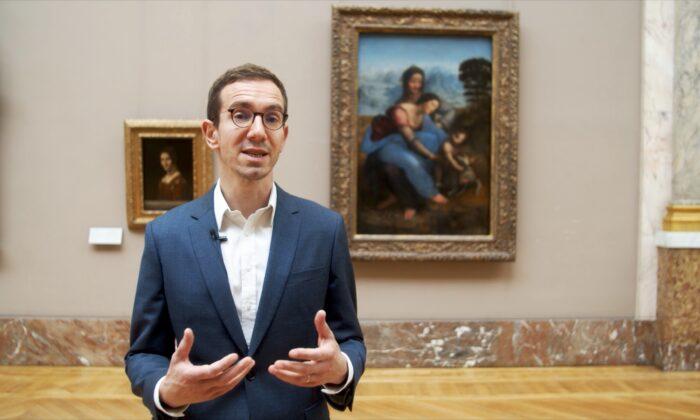This subject, this composition, “The Virgin and Child with Saint Anne,” is really very symbolic. Leonardo da Vinci spent nearly 20 years conceiving it. From 1500 to his death in 1519, he never stopped perfecting every detail, and transforming his ideas.
For him, every part of the painting was fundamental, because he really wanted to portray something very particular—the very moment when the Virgin agreed to let Jesus go to his destiny. It is something very subtle that reveals it: a movement, one could say, between the moment Christ returns to the arms of the Virgin, and the moment she lets him go toward his destiny.
What is fundamental for Leonardo, is the expression of feelings, and especially a perfect correspondence between the movement of the body and the movement of the mind. Here, the three protagonists, Saint Anne, the Virgin, and the Child, unfold differently.
We see that Jesus takes hold of a lamb, the symbol of his approaching death, the sacrificial animal. He turns, and with a bit of mischief, he smiles. It looks like they are playing with the animal, but in fact, he looks back at his mother and grandmother to see if they understood the true meaning of this gesture, this game that was the announcement of his death. Then he smiles too, in a way, to reassure them.
There are two different reactions to this moment. Saint Anne, the grandmother, already knows. She knows that this death is essential for the redemption of humanity, and therefore, she decides not to intervene. She looks passive but bares a broad smile that shows she knows it was destiny, certainly tragic, but at the same time, wonderful.

On the other hand, the most ambiguous expression, the most subtle—the most moving too—is that of the Virgin, who is presented in a physical and spiritual moment of conflict with herself. And this is what da Vinci places at the center of his composition. She is in a particular moment—between wanting to hold her son, to separate him from the lamb, and therefore, keep him alive. And yet, there is a smile on her face in which we guess is a little melancholy, and it expresses her acceptance. She is accepting this destiny, and she is going to let him go to his future death. So, it’s something very subtle, and that is what makes “Saint Anne” the great masterpiece in the expression of human feelings, and also, in the expression of movement.
Here is a world that includes everything: sweetness, joy, melancholy, and movements partly contradictory, but that are nevertheless resolved in a rather joyful atmosphere at the end. And the landscape is a character in and of itself.
It’s a wonderful and scientific representation of nature, but there are also elements in this landscape that are both extremely calm, reassuring, and distant—a great sense of perspective that invites us to see things with a long view. And when we approach the painting, we see this great cascade of water, absolutely extraordinary, which shows that this journey will also be strewn with pitfalls, in particular by the death of Christ.





